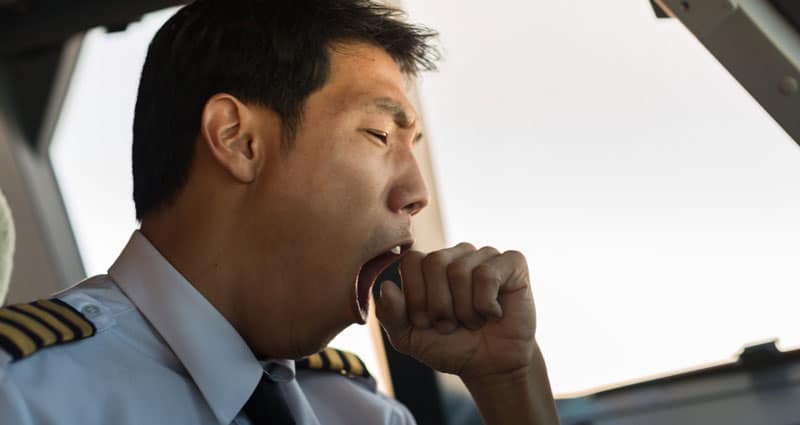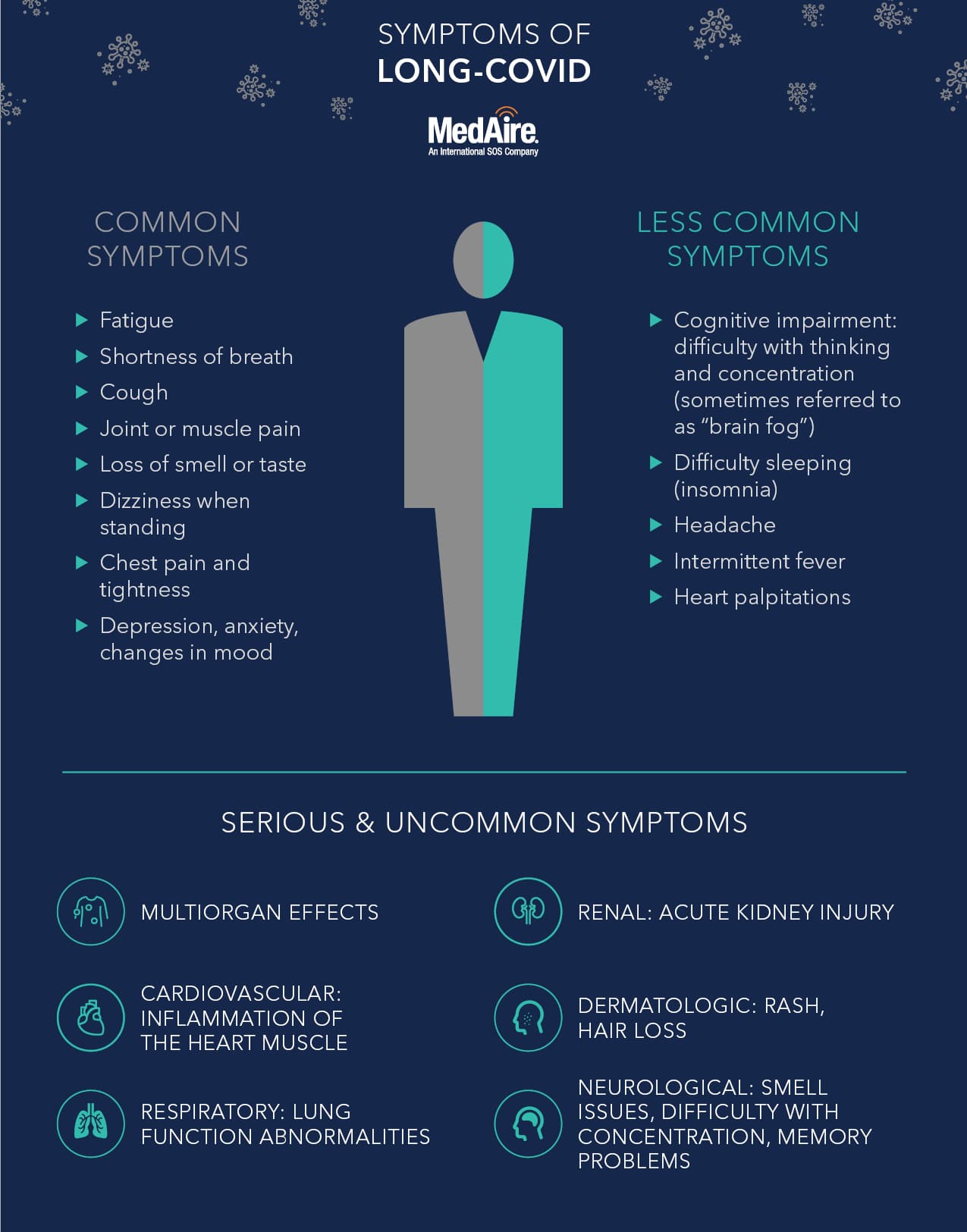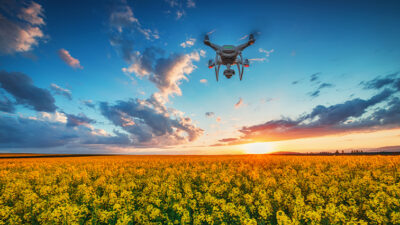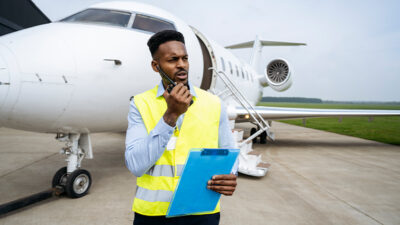Long-COVID Another Challenge for a Safe Operation

ARTICLE CONTRIBUTERS: Dr Olivier Lo, Rita Dayoub, Mandy Eddington
Most people infected with Covid-19 will recover from their symptoms, if any, in a maximum period of four weeks. However, 10-30% of people diagnosed with COVID-19 will experience long-term after-effects. When existing symptoms last longer than expected or new ones develop following the acute phase of COVID-19 infection, it is referred to as “ongoing” symptomatic COVID-19 (from four to twelve weeks). In some instances, this could also lead to more chronic conditions, usually identified as Post-Acute Covid-19 Sequelae (PASC) by the experts on the matter when signs and symptoms continue for more than twelve weeks. For simplicity, many use the term “Long-COVID” to describe signs and symptoms that continue to develop after “acute” COVID-19. Thus, it includes both ongoing symptomatic and PASC.
To put these numbers in perspective, 1 in 10 of those who’ve tested positive for COVID in the UK are developing long COVID. With the progress the pandemic, researchers are still learning from emerging data. Initial findings show that long-covid patients average around 40 years-old.
Long-COVID symptoms present as a wide range of new, returning, or ongoing health problems people experience four or more weeks after being infected. Even people who did not have symptoms while they were in the acute phase of the infection can develop post-COVID conditions. The most common long-COVID symptoms include fatigue, shortness of breath, cough, joint or muscle pain, chest pain and tightness, depression, anxiety, changes in mood, cognitive impairment (sometimes referred to as “brain fog”), headache, intermittent fever, and loss of taste and smell.
Given the nature of the symptoms, with particular attention to those in the mental health sphere, the potential repercussions on employee’s health and flight safety are real and concerning. As such, there are various questions operators need to consider when planning how to approach and effectively manage this emerging and concerning development. For example, what should be considered when managing return-to-work for long-COVID employees? How can an operator ensure a safe work & cabin environment despite long-COVID risks? How can long-COVID impact productivity and business continuity?

Below are few recommendations to help navigate operators through these questions.
- Align your HR policies
Long-COVID can imply prolonged absenteeism, resulting from the patient difficulty coping. Consider adding extended absenteeism language in your HR policies with clear directions for such situations. Though it is not a legal requirement today, as with all things COVID related, this could change rapidly and vary from country to country. Remain informed on the latest legal regulations and requirements on this matter to stay compliant. As we learn more about long-COVID and its implications, it might be considered a chronic condition for more severe cases and thus be in the HR policies as any other disability or chronic disease. - Consider Recruitment Strategies
With the industry facing a pilot shortage, and a shallow talent pool for cabin crew and support functions, aviation operators could find themselves in a difficult situation if they have a crewmember out due to long COVID. Whether a crewmember develops symptoms and can’t work, or an entire crew gets quarantined out of the country, operators may struggle to find a suitable replacement. For this reason, operators may want to look at their existing recruitment strategy and modify it as needed to ensure they never have to cancel or delay a flight due to staffing issues. - Fit-to-Operate Procedures
If you do not have a fit-to-operate evaluation already in place, now is the time to get one. If it is a crewmember that has been impacted by long COVID, you will need to have strong guidance to follow to know when it is safe for them to work again. Symptoms such as cognitive impairment & fatigue pose a massive threat to aviation. Operators need to double down on their safety protocols and fatigue reporting now more than ever. There is no place for brain fog or chronic fatigue at 20,000+ feet. Additionally, while it may seem like a harmless symptom, loss of smell could have ramifications in the aviation environment. Crew need to be able to have all senses intact to operate safely as in a case of the early stages of a fire in the cabin, when smell is the first sense to be triggered. - Educate and communicate about long-COVID
Make sure your people are aware of what the long-COVID condition and associated symptoms could be. Awareness will help catch the virus at an early stage. Encourage your workforce to notify their long-COVID condition so you can have it in consideration in your return-to-operation process. - Educate and communicate about vaccination
Remember, the best way to prevent getting COVID-19 is by getting vaccinated. Although not 100% efficient to prevent the disease, vaccination significantly reduces the chances for severe infection causing hospitalization or even death. In addition, some initial studies have surprisingly shown patients recovering from Long-Covid symptoms after being vaccinated. - Travel Restrictions & Quarantining
If a crewmember tests positive outside their home county, they can be placed into mandatory quarantine – along with everyone else who travelled onboard. These quarantine situations can be strict. Many places have government run facilities that are not up to standards for those who fly private. To avoid any unnecessary quarantine mandates, know the entry/exit requirements of any country you are travelling to. - Testing Programs
Until we are at a place where the world has a higher vaccination rate and declining cases, routine testing programs should stay in place. Testing programs should cover employees, crew, and passengers. Routine testing can reduce the risk of spreading the virus. It can also mitigate risks such as learning upon landing that someone has tested positive for COVID and now facing unwanted quarantine or isolation abroad. - Reinforce your mental health & wellbeing agenda
The pandemic has created mental health and emotional struggles globally. Individuals who suffered from COVID-19 and recovered have a higher probability of experiencing an emotional health issue. There is risk is even greater for those experiencing long-COVID. Make sure employees have access to care for their emotional needs.

Flight departments around the world rely on MedAire, an International SOS company, to reduce their travel safety risks. Crews are trained on the resources to manage in-flight illness and injury with onboard medical equipment and telemedicine assistance. On the ground, passengers and crew have one resource for medical referrals; guaranteed payments for medical expenses; assistance with lost documents and prescriptions; online and e-mail travel advisories; evacuation support and a host of other services.
http://www.medaire.com/
© 2025 MedAire Worldwide. All Rights Reserved.
Next ArticleRelated Posts

Part 108: The Next Step in BVLOS Integration and Drone Innovation
As the drone industry awaits the Federal Aviation Administration’s (FAA) forthcoming Part 108 regulations, the landscape of Beyond Visual Line of Sight (BVLOS) operations stands on the brink of transformation. These anticipated rules aim to standardize BVLOS flights, enabling more complex and expansive drone missions across various sectors.

Giving the Hazard Log the Attention It Deserves
Safety risk profile. Hazard log. Hazard risk register. Whatever you call it internally, one thing is clear: It is a fundamental requirement in your safety management system.

